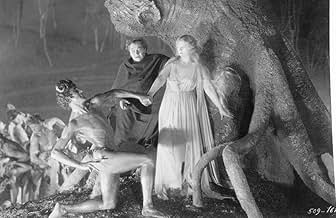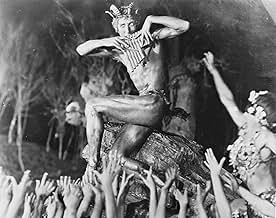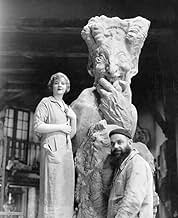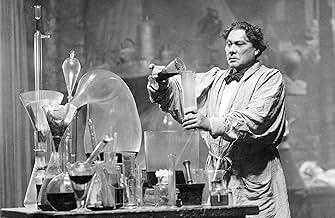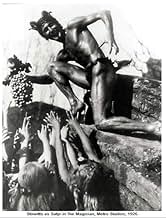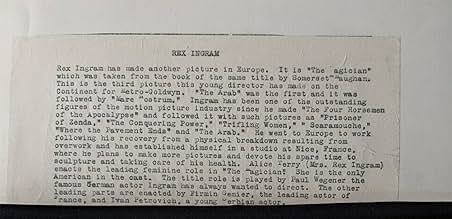Füge eine Handlung in deiner Sprache hinzuA magician/alchemist, seeking to create life, finds that he needs the "blood of a virgin" to continue his experiments. He sends out his dwarf assistant to pick out the right girl.A magician/alchemist, seeking to create life, finds that he needs the "blood of a virgin" to continue his experiments. He sends out his dwarf assistant to pick out the right girl.A magician/alchemist, seeking to create life, finds that he needs the "blood of a virgin" to continue his experiments. He sends out his dwarf assistant to pick out the right girl.
- Regie
- Drehbuch
- Hauptbesetzung
Hubert I. Stowitts
- Dancing Faun
- (as Stowitts)
Claude Fielding
- Dancing Faun
- (Nicht genannt)
Gerald Fielding
- Dancing Faun
- (Nicht genannt)
Rosita Garcia
- Arab Girl Bitten by Snake
- (Nicht genannt)
John George
- Haddo's Dwarf Servant
- (Nicht genannt)
Michael Powell
- Man with Balloon at Snake Charming
- (Nicht genannt)
Empfohlene Bewertungen
Until a few months ago, when Michael Elliott added it to his list of films watched to be exact, I was under the impression that this was a lost title a view which was certainly true till the late 70s since Carlos Clarens, in his wonderful 1967 "Horror Movies" book, called it "probably the most elusive of lost movies" and even Leslie Halliwell, in the 1977 edition of his famous "Film Guide", gives it as unavailable for reappraisal! Indeed, virtually the only way I had previously known this film was via one intriguing still of the Hades sequence found in the section devoted to director Rex Ingram in the periodical "The Movies" (published in the early 80s)
so, it's great that THE MAGICIAN has eventually seen the light of day (albeit unofficially) and, thankfully, it lives up to its considerable reputation to my eyes, at least.
Ingram was one of Silent cinema's master visual stylists but is now a forgotten figure best-known for the Rudolph Valentino version of THE FOUR HORSEMAN OF THE APOCALYSE (1921); his retirement from films once Talkies came in suggests that, like D.W. Griffith, he was unable to adapt to the ongoing progress in cinematic technique and, indeed, his films like Griffith's have an inherently stilted quality to them which dates his output more than those of contemporary auteurs! Anyway, this was my fourth Ingram movie after the interesting THE CONQUERING POWER (1921), the fine if somewhat underwhelming THE PRISONER OF ZENDA (1922) and the rousing SCARAMOUCHE (1923); unfortunately, my copy of MARE NOSTRUM (1926) recorded off TCM UK got erased by accident before I had the opportunity to watch it. Alice Terry, Ingram's wife, appeared in 15 of his films and here plays the distressed virginal heroine who's the prime ingredient for the experiment concocted by the magician of the title (Paul Wegener). The latter, best-known for his three "Golem" pictures made at the height of the "German Expressionist" movement, makes for an overwhelmingly menacing villain although I found his being a medical student quite amusing (Wegener was 52 at the time of filming!). By the way, the character of Oliver Haddo was based by novelist W. Somerset Maugham on notorious English Occultist and writer Aleister Crowley! The film, an MGM production but shot in France (where Ingram lived), is ostensibly a variation on the Frankenstein myth with a few Svengali overtones thrown in for good measure; interestingly, Paul Wegener would star in an official version of that one in Germany the following year. Ingram's assistant director was the future iconoclastic English film-maker, Michael Powell, who also appears unbilled in a snake-charming sequence around the middle of the film! As expected, the film is pictorially quite stylish (shot by frequent Rex Ingram, Preston Sturges and Billy Wilder lenser, John F. Seitz), especially in the fantasy sequence set in Hades which must surely have left an indelible impression on Ingram's production manager here, Harry Lachman, to refer back to it when he came to direct the Spencer Tracy version of DANTE'S INFERNO (1935) and the finale set in a laboratory on a remote mountaintop, which uncannily prefigures (literally step by step) the similar climax at the end of James Whale's BRIDE OF FRANKENSTEIN (1935)!; as a matter of fact, Wegener even has a dwarfish assistant a' la Dwight Frye in Whale's FRANKENSTEIN (1931) so, it's very possible that Whale had seen Ingram's film.
One is all the more grateful, then, that a print of THE MAGICIAN has survived since it helps throw more light on the influences behind the greatest horror film ever made (which also happens to be my all-time favorite film)
Ingram was one of Silent cinema's master visual stylists but is now a forgotten figure best-known for the Rudolph Valentino version of THE FOUR HORSEMAN OF THE APOCALYSE (1921); his retirement from films once Talkies came in suggests that, like D.W. Griffith, he was unable to adapt to the ongoing progress in cinematic technique and, indeed, his films like Griffith's have an inherently stilted quality to them which dates his output more than those of contemporary auteurs! Anyway, this was my fourth Ingram movie after the interesting THE CONQUERING POWER (1921), the fine if somewhat underwhelming THE PRISONER OF ZENDA (1922) and the rousing SCARAMOUCHE (1923); unfortunately, my copy of MARE NOSTRUM (1926) recorded off TCM UK got erased by accident before I had the opportunity to watch it. Alice Terry, Ingram's wife, appeared in 15 of his films and here plays the distressed virginal heroine who's the prime ingredient for the experiment concocted by the magician of the title (Paul Wegener). The latter, best-known for his three "Golem" pictures made at the height of the "German Expressionist" movement, makes for an overwhelmingly menacing villain although I found his being a medical student quite amusing (Wegener was 52 at the time of filming!). By the way, the character of Oliver Haddo was based by novelist W. Somerset Maugham on notorious English Occultist and writer Aleister Crowley! The film, an MGM production but shot in France (where Ingram lived), is ostensibly a variation on the Frankenstein myth with a few Svengali overtones thrown in for good measure; interestingly, Paul Wegener would star in an official version of that one in Germany the following year. Ingram's assistant director was the future iconoclastic English film-maker, Michael Powell, who also appears unbilled in a snake-charming sequence around the middle of the film! As expected, the film is pictorially quite stylish (shot by frequent Rex Ingram, Preston Sturges and Billy Wilder lenser, John F. Seitz), especially in the fantasy sequence set in Hades which must surely have left an indelible impression on Ingram's production manager here, Harry Lachman, to refer back to it when he came to direct the Spencer Tracy version of DANTE'S INFERNO (1935) and the finale set in a laboratory on a remote mountaintop, which uncannily prefigures (literally step by step) the similar climax at the end of James Whale's BRIDE OF FRANKENSTEIN (1935)!; as a matter of fact, Wegener even has a dwarfish assistant a' la Dwight Frye in Whale's FRANKENSTEIN (1931) so, it's very possible that Whale had seen Ingram's film.
One is all the more grateful, then, that a print of THE MAGICIAN has survived since it helps throw more light on the influences behind the greatest horror film ever made (which also happens to be my all-time favorite film)
Practically every element of this film holds up very well here in the twenty-first century, eighty-four years after the movie was made - the writing, the casting, the directing (and art direction), the photography (both indoor and outdoor), the "costumes" and "sets" (really, the fashions and architecture of the era were a captivating delight), and most of the acting. I say "most" because the only thing that seemed dated in this post-feminist era was the woe-is-me attitude of the hapless heroine.
Particularly well-cast in terms of "looking the part" were the two male leads, both protagonist and antagonist. (After all, these were not speaking parts, so look was of high importance.)
Surprisingly enjoyable were some quite subtle, non-intrusive comedic tension-breakers by peripheral characters, including some clever silent movie sight gags.
The main recommendation I can make for seeing this film, however, is the clarity of the photography, both for the close-ups, and for some wonderful outdoor set pieces.
Particularly well-cast in terms of "looking the part" were the two male leads, both protagonist and antagonist. (After all, these were not speaking parts, so look was of high importance.)
Surprisingly enjoyable were some quite subtle, non-intrusive comedic tension-breakers by peripheral characters, including some clever silent movie sight gags.
The main recommendation I can make for seeing this film, however, is the clarity of the photography, both for the close-ups, and for some wonderful outdoor set pieces.
In the 1920s films dealing with supernatural evil were extremely rare. However, director Rex Ingram, obviously influenced by earlier German forays into the supernatural, cast German actor Paul Wegener of DER GOLEM in this adaptation of Somerset Maugham's novel THE MAGICIAN. Wegener's menacing performance as an evil Yogi in LEBENDE BUDDHAS (1925) made him a good choice to play Oliver Haddo, obsessed with creating life from an ancient formula requiring the heart's blood of a maiden, played by Ingram's wife Alice Terry.
John F. Seitz' cinematography is superb, especially in the depiction of the heroine's hallucinatory descent into Hell where she is figuratively ravished by a lustful and athletic satyr. And although Haddo doesn't succeed in creating the grisly, half-complete humans as in the novel, the controversial subject matter was nevertheless strong enough to insure the film's failure at the box-office in 1926.
Interesting comparisons have been made between this film and James Wale's FRANKENSTEIN, but the subject of black magic also invites comparison with later films - THE BLACK CAT (1934), THE NIGHT OF THE DEMON (1957), and THE DEVIL RIDES OUT (1968) - featuring characters who like Oliver Haddo were modeled on real-life occultist Aleister Crowley.
John F. Seitz' cinematography is superb, especially in the depiction of the heroine's hallucinatory descent into Hell where she is figuratively ravished by a lustful and athletic satyr. And although Haddo doesn't succeed in creating the grisly, half-complete humans as in the novel, the controversial subject matter was nevertheless strong enough to insure the film's failure at the box-office in 1926.
Interesting comparisons have been made between this film and James Wale's FRANKENSTEIN, but the subject of black magic also invites comparison with later films - THE BLACK CAT (1934), THE NIGHT OF THE DEMON (1957), and THE DEVIL RIDES OUT (1968) - featuring characters who like Oliver Haddo were modeled on real-life occultist Aleister Crowley.
Beautiful Margaret Dauncey (Alice Terry) is set to marry young handsome Dr. Arthur Burdon (Ivan Petrovich). They meet an evil magician named Oliver Haddo (Paul Wegener) who is trying to create life. He needs the blood of someone whose profile fits Margaret's perfectly...and he'll so ANYTHING to get it.
Hard to see silent. I want to thank TCM for showing it about a week ago. The print was in pretty good shape with tinting and an amusing music score (LOVED when they used "Night on Bald Mountain"). The movie was made with a pretty big budget--the settings are incredible--and has a good script that follows many horror film clichés--but in a good way. Heck, it all ends on a dark and stormy night and in a CASTLE! Also there's a trip to Hell which is a real jaw dropper. The acting varies. Terry was a star of the silent screen and it's easy to see why. She was a beautiful woman AND a good actress. She's just great here. Wegener chews the scenery again and again and AGAIN as the mad magician. He really overdoes it--but it's pretty amusing. Petrovich is given nothing to do as the doctor but him and Terry make a very good-looking couple. Beautifully directed by Rex Ingram too (who was Terry's husband). Well worth seeing--if you can.
Hard to see silent. I want to thank TCM for showing it about a week ago. The print was in pretty good shape with tinting and an amusing music score (LOVED when they used "Night on Bald Mountain"). The movie was made with a pretty big budget--the settings are incredible--and has a good script that follows many horror film clichés--but in a good way. Heck, it all ends on a dark and stormy night and in a CASTLE! Also there's a trip to Hell which is a real jaw dropper. The acting varies. Terry was a star of the silent screen and it's easy to see why. She was a beautiful woman AND a good actress. She's just great here. Wegener chews the scenery again and again and AGAIN as the mad magician. He really overdoes it--but it's pretty amusing. Petrovich is given nothing to do as the doctor but him and Terry make a very good-looking couple. Beautifully directed by Rex Ingram too (who was Terry's husband). Well worth seeing--if you can.
I read Carlos Clarens "Horror Movies" in '68 and it was one of the bigger influences on my movie tastes (as was seeing my first movie "House on Haunted Hill" in the theater with Emergo when I was five years old) so I'm inclined to recommend this movie for those who would like a fluid distillation of what was best about the silent cinema.
I saw it at the Film Forum in NYC around '92 or '93. Ingram had moved to France and The Magician is notable for its documentary footage of Paris, Monaco and the French countryside. Wegener is a formidably grotesque presence and there is a remarkable set piece at the very beginning when a huge clay sculpture collapses, seeming at first to come to life, sending Alice Terry to the hospital. Oliver Haddo, the magician of the title, lurks in the observation gallery as a life saving operation is performed on her...
This movie really has it all so don't miss it if you get the chance especially if you can see it with live musical accompaniment.
I saw it at the Film Forum in NYC around '92 or '93. Ingram had moved to France and The Magician is notable for its documentary footage of Paris, Monaco and the French countryside. Wegener is a formidably grotesque presence and there is a remarkable set piece at the very beginning when a huge clay sculpture collapses, seeming at first to come to life, sending Alice Terry to the hospital. Oliver Haddo, the magician of the title, lurks in the observation gallery as a life saving operation is performed on her...
This movie really has it all so don't miss it if you get the chance especially if you can see it with live musical accompaniment.
Wusstest du schon
- WissenswertesThis movie, especially the explosion of the laboratory, influenced James Whale while making the Frankenstein (1931) movies.
- Zitate
Dr. Arthur Burdon: Your niece is certainly the most beautiful patient I have ever had.
Top-Auswahl
Melde dich zum Bewerten an und greife auf die Watchlist für personalisierte Empfehlungen zu.
Details
- Laufzeit
- 1 Std. 23 Min.(83 min)
- Sound-Mix
- Seitenverhältnis
- 1.33 : 1
Zu dieser Seite beitragen
Bearbeitung vorschlagen oder fehlenden Inhalt hinzufügen

